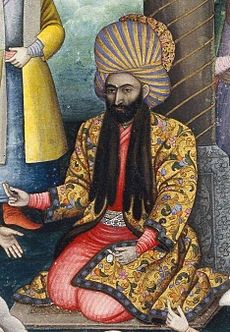Sultan Husayn
| Shah Sultan Husayn | |
|---|---|
| Shahanshah of Iran |
|

Sultan Husayn Safavi, by Mohammad Ali Ibn Mohammad Zaman
|
|
| 9th Safavid Shah | |
| Reign | 1694–1722 |
| Coronation | 1694 |
| Predecessor | Suleiman I |
| Successor |
Tahmasp II (Qazvin) Mahmud Hotaki (Isfahan) |
| Born | October 1668 |
| Died | November 1726 Isfahan |
| House | Safavid |
| Father | Suleiman I |
Sultan Husayn (also known as Soltan Hosayn and Soltan Hosein), (October 1668 – November 1726) (Persian: شاه سلطان حسین) reigned 1694–1722; was a Safavid Shah of Iran (Persia). He ruled from 1694 until he was overthrown in 1722 by rebellious marauder Mahmud Hotaki, an Afghan of Pashtun ethnic background. His reign saw the downfall of the Safavid dynasty, which had ruled Persia since the beginning of the 16th century.
When his father Shah Suleiman was on his deathbed, he asked his court eunuchs to choose between his two sons, saying that if they wanted peace and quiet they should pick the elder, Sultan Husayn, but if they wanted to make the empire more powerful then they should opt for the younger, Abbas. They decided to make Sultan Husayn shah. He had a reputation for being easy-going and had little interest in political affairs, his nickname being Yakhshidir ("Very well!"), the response he was said to give when asked to decide on matters of state. The young king was a devout Muslim and one of his first acts was to give power to the leading cleric Muhammad Baqer Majlesi. A series of measures against the Sufi order were introduced as well as legislation prohibiting the consumption of alcohol and opium and restrictions on the behaviour of women in public. Provincial governors were ordered to enforce Sharia law.
However, power soon shifted away from Muhammad Baqer Majlesi to Sultan Husayn's great aunt, Maryam Begum (the daughter of Shah Safi). Under her influence, Hosein became an alcoholic and paid less and less attention to political affairs, devoting his time to his harem and his pleasure gardens.
...
Wikipedia
